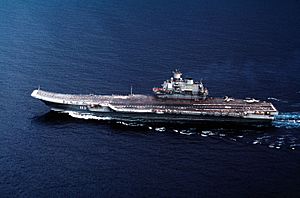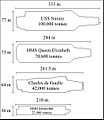Aircraft carrier facts for kids
Aircraft carriers are huge warships that act like floating airports. They carry many airplanes and helicopters. Navies use them so their aircraft can fly missions and fight alongside other warships far out at sea. Aircraft carriers are usually very big, carrying hundreds or even thousands of sailors and many aircraft.
The top of an aircraft carrier is called the flight deck. It looks just like a runway at a small airport. Some older carriers, and smaller modern ones, carry planes like the Harrier that can take off and land almost straight up and down. This means they don't need a long runway.
Contents
How Planes Take Off and Land
Large, modern aircraft carriers have special areas for planes to take off and land.
Landing on the Deck
The landing area is at the back of the ship. It has a short runway. When an airplane lands, it uses a special hook on its back. This hook catches strong wires stretched across the runway. This helps the plane stop very quickly on the short deck.
Launching from the Deck
At the front of the flight deck, there's a powerful steam-powered catapult. This catapult connects to the front wheel of an airplane. It quickly pulls and throws the plane off the deck, helping it get enough speed to fly into the air. So, aircraft carriers are basically mobile, floating airports that can move anywhere in the ocean.
Powering These Giant Ships
Because aircraft carriers are so big and need a lot of electric power, many large, modern ones have nuclear power plants on board. These plants create the energy needed for the ship and its systems. Other carriers use engines that burn oil for power.
Carrier Groups
Aircraft carriers usually have very few weapons themselves, apart from their planes. This is because their main job is to carry and launch aircraft. So, other warships travel with them to protect them. Together, the aircraft carrier and its protecting warships form a carrier group. This group works as a team to defend itself and carry out missions.
Images for kids
-
Four modern aircraft carriers of various types—USS John C. Stennis, Charles de Gaulle (French Navy), USS John F. Kennedy, helicopter carrier HMS Ocean—and escort vessels, 2002
-
The French aircraft carrier Charles de Gaulle (at the back) and the US Navy carrier USS Ronald Reagan working together in the Persian Gulf. Both use the CATOBAR system for launching planes.
-
USS Abraham Lincoln (CVN-72), a United States Navy fleet carrier, also called a supercarrier, sailing in 2019.
-
USS Enterprise, the most decorated US warship of World War II.
-
An F6F-5 landing on the French Arromanches in 1953.
-
USS Tripoli, a U.S. Navy Iwo Jima-class helicopter carrier.
-
The first time a jet aircraft landed and took off from a carrier: Eric "Winkle" Brown landing on HMS Ocean in 1945.
-
Catapult launches aboard USS Ronald Reagan.
-
The aircraft carrier Charles de Gaulle of the French Navy.
-
The Spanish Juan Carlos I with a Harrier II jet.
-
HMS Queen Elizabeth, a Royal Navy aircraft carrier and lead ship of her class.
-
USS Nimitz (CVN-68), the first ship of her class, seen here in 2009. She started service in 1975.
-
USS Enterprise (CVN-80), the third US Navy carrier with this name. She is a Gerald R. Ford-class carrier being built now and expected to join the navy in 2028. (This is an artist's drawing).
See also
 In Spanish: Portaviones para niños
In Spanish: Portaviones para niños




























